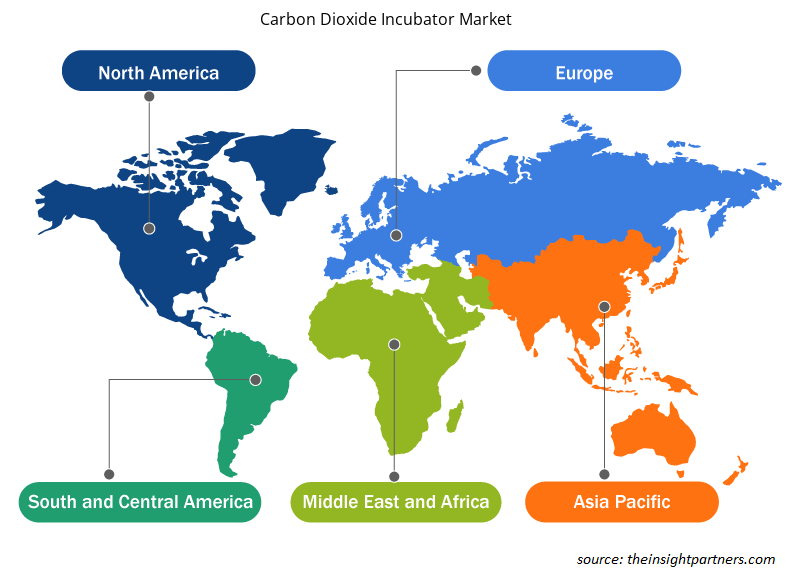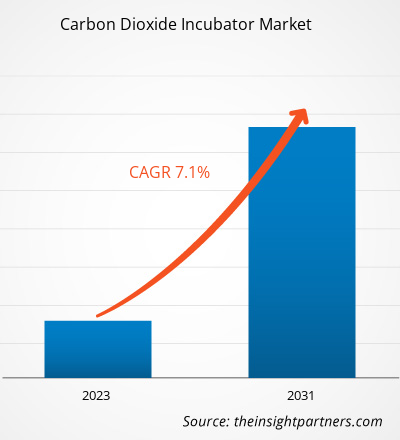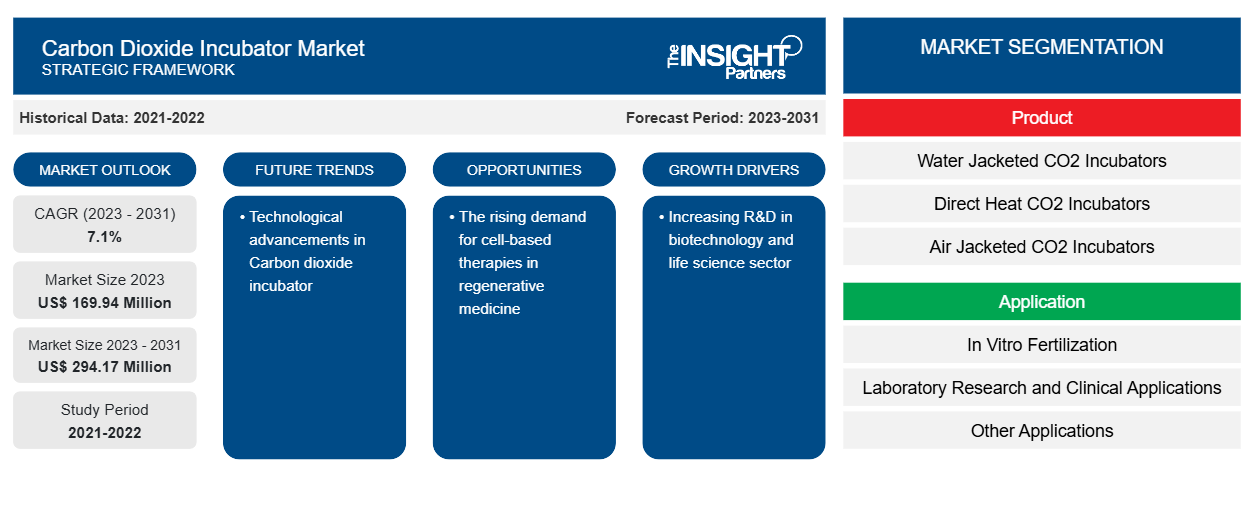Der Markt für Kohlendioxid-Inkubatoren (CO2) soll von 169,94 Millionen US-Dollar im Jahr 2023 auf 294,17 Millionen US-Dollar im Jahr 2031 anwachsen. Der Markt soll zwischen 2023 und 2031 eine durchschnittliche jährliche Wachstumsrate (CAGR ) von 7,1 % verzeichnen. Das Marktwachstum ist auf das schnelle Wachstum im Biowissenschaftssektor sowie auf die steigenden Investitionen im Biotechnologie- und Biowissenschaftssektor und das steigende Bewusstsein für die Vorteile von Kohlendioxid im Forschungssektor zurückzuführen.
Kohlendioxid-Inkubator Marktanalyse
Der schnell wachsende Sektor der Biowissenschaften und Biotechnologie sowie der technologische Fortschritt bei Kohlendioxid-Inkubatoren sind die Hauptfaktoren, die das Marktwachstum vorantreiben. Darüber hinaus wird erwartet, dass schnelle Innovationen in der Automatisierung sowie die schnelle Einführung dieser Inkubatoren für die Lagerung und Züchtung von Zellen wie Stammzellen, Embryonalzellen und Säugetierzellenkultivierung unter Forschern ebenfalls das Wachstum des Marktes vorantreiben.
Kohlendioxid-Inkubator Marktübersicht
Nordamerika ist der größte Markt für das Wachstum des Kohlendioxid-Inkubator-Marktes, wobei die USA den größten Marktanteil halten, gefolgt von Kanada. Der nordamerikanische Kohlendioxid-Inkubator-Markt wird durch die steigende Nachfrage nach Kohlendioxid-Inkubatoren durch Labore in nordamerikanischen Ländern angetrieben, da diese Inkubatoren eine kontrollierte Umgebung für Zellkultur- und Gewebezüchtungsanwendungen bieten sollen. Die steigende Nachfrage nach diesen Inkubatoren ist auch auf ihre verschiedenen Vorteile zurückzuführen, wie z. B. die Aufrechterhaltung optimaler Bedingungen, einschließlich Luftfeuchtigkeit, Temperatur und Kohlendioxidwerte, um das Wachstum und die Lebensfähigkeit von Zellen, Geweben und Mikroorganismen für Forschungs-, Klinik- und Industrieaktivitäten in Nordamerika zu unterstützen.
Passen Sie diesen Bericht Ihren Anforderungen an
Sie erhalten kostenlose Anpassungen an jedem Bericht, einschließlich Teilen dieses Berichts oder einer Analyse auf Länderebene, eines Excel-Datenpakets sowie tolle Angebote und Rabatte für Start-ups und Universitäten.
- Holen Sie sich die wichtigsten Markttrends aus diesem Bericht.Dieses KOSTENLOSE Beispiel umfasst eine Datenanalyse von Markttrends bis hin zu Schätzungen und Prognosen.
Treiber und Chancen auf dem Kohlendioxid-Inkubatormarkt
Wachsende Nachfrage nach Kohlendioxid-Inkubatoren aus dem Biotechnologie- und Life-Science-Sektor begünstigt den Markt
Die Nachfrage nach Kohlendioxid-Inkubatoren ist in den Bereichen Biowissenschaften und Biotechnologie gestiegen. Diese Bereiche sind in hohem Maße auf diese Inkubatoren angewiesen, um eine kontrollierte Umgebung für die Zellen aufrechtzuerhalten, die für Forschungstätigkeiten verwendet werden. CO2-Inkubatoren sind ein wichtiges Instrument zur Aufrechterhaltung von Temperatur, Luftfeuchtigkeit und CO2-Niveau, um die Lebensfähigkeit der Zellkultur zu unterstützen. Darüber hinaus wirken die steigenden Ausgaben für Forschung und Entwicklung und die zentrale Rolle dieser Inkubatoren für Spitzenforschung in diesen Bereichen als Katalysatoren für den CO2-Inkubatormarkt.
Darüber hinaus gewinnen auch zellbasierte Therapien an Bedeutung, da für diese Therapien CO2-Inkubatoren erforderlich sind. Diese Therapien verwenden CO2-Inkubatoren zur Behandlung von Krankheiten und basieren auch auf der Aufrechterhaltung der Zelllebensfähigkeit und -funktion. Daher fördert die steigende Nachfrage nach CO2-Inkubatoren für zellbasierte Therapien das allgemeine Marktwachstum weiter.
Schnelle Innovation und technologische Weiterentwicklung im Kohlendioxid-Inkubator – eine Chance auf dem Kohlendioxid-Inkubator-Markt
Verbesserte Temperatur- und Gaskontrollsysteme sowie Datenaufzeichnung mit Fernüberwachungsfunktionen sind einige der Funktionen, die in aktuellen CO2-Inkubatoren verbessert werden. Diese Verbesserungen decken nicht nur den steigenden Bedarf an Forschern ab, sondern tragen auch zur Markterweiterung bei. Die Inkubatoren wurden auch während des Coronavirus-Ausbruchs verwendet. Ein Kohlendioxid-Inkubator wurde zur Lagerung von Coronavirus-Proben verwendet. Beispielsweise werden BINDER CO2-Inkubatoren, die auf bis zu 180 °C erhitzt werden können, verwendet, um schwere Infektionen an menschlichen Zellen zu reproduzieren und neue Erkenntnisse über die SARS-CoV-2-Infektion zu gewinnen. Daher wird erwartet, dass die zunehmende Verwendung dieser Inkubatoren das allgemeine Marktwachstum vorantreiben wird.
Segmentierungsanalyse des Kohlendioxid-Inkubator-Marktberichts
Wichtige Segmente, die zur Ableitung der Marktanalyse für Kohlendioxid-Inkubatoren beigetragen haben, sind Produkt, Anwendung und Kapazität.
- Basierend auf dem Produkt ist der Markt für Kohlendioxid-Inkubatoren in wasserummantelte CO2-Inkubatoren, CO2-Inkubatoren mit Direktheizung und CO2-Inkubatoren mit Luftmantel unterteilt. Die wasserummantelten CO2-Inkubatoren hatten 2023 einen größeren Marktanteil.
- Nach Anwendung ist der Markt in In-vitro-Fertilisation, Laborforschung und klinische Anwendungen sowie andere Anwendungen unterteilt. Das Segment In-vitro-Fertilisation hatte im Jahr 2023 den größten Marktanteil.
- Nach Kapazität ist der Markt in Unter 100 l, Über 100 l und Unter 200 l, Über 200 l segmentiert. Das Segment über 200 l hielt im Jahr 2023 den größten Marktanteil.
Kohlendioxid-Inkubator Marktanteilsanalyse nach Geografie
Der geografische Umfang des Berichts zum Kohlendioxid-Inkubator-Markt ist hauptsächlich in fünf Regionen unterteilt: Nordamerika, Asien-Pazifik, Europa, Naher Osten und Afrika sowie Südamerika/Süd- und Mittelamerika. Nordamerika dominierte den Kohlendioxid-Inkubator-Markt. Das Marktwachstum ist auf zunehmende Forschungs- und Entwicklungsaktivitäten in den Bereichen Biowissenschaften und Biotechnologie sowie auf die Präsenz großer Hersteller auf dem Markt zurückzuführen, die sich auf Produktangebote konzentrieren. So dürfte beispielsweise auch die starke Präsenz von Unternehmen wie Thermo Fisher Scientific, Inc. in den USA das regionale Marktwachstum ankurbeln. So stellte Thermo Fisher Scientific Inc. im Mai 2021 den Thermo Scientific Heracell Vios CR CO2-Inkubator vor, der Leistungszuverlässigkeit, einheitliche Bedingungen und Benutzerfreundlichkeit bietet, um eine Reihe anspruchsvoller Zellkulturanwendungen zu unterstützen. Solche Produkteinführungen werden dem regionalen Markt helfen, schneller zu wachsen
Regionale Einblicke in den Kohlendioxid-Inkubatormarkt
Die regionalen Trends und Faktoren, die den Kohlendioxid-Inkubatormarkt während des Prognosezeitraums beeinflussen, wurden von den Analysten von Insight Partners ausführlich erläutert. In diesem Abschnitt werden auch die Marktsegmente und die Geografie des Kohlendioxid-Inkubatormarkts in Nordamerika, Europa, im asiatisch-pazifischen Raum, im Nahen Osten und Afrika sowie in Süd- und Mittelamerika erörtert.

- Erhalten Sie regionale Daten zum Kohlendioxid-Inkubatormarkt
Umfang des Marktberichts über Kohlendioxid-Inkubatoren
| Berichtsattribut | Details |
|---|---|
| Marktgröße im Jahr 2023 | 169,94 Millionen US-Dollar |
| Marktgröße bis 2031 | 294,17 Millionen US-Dollar |
| Globale CAGR (2023 - 2031) | 7,1 % |
| Historische Daten | 2021-2022 |
| Prognosezeitraum | 2023–2031 |
| Abgedeckte Segmente | Nach Produkt
|
| Abgedeckte Regionen und Länder | Nordamerika
|
| Marktführer und wichtige Unternehmensprofile |
|
Marktteilnehmerdichte: Der Einfluss auf die Geschäftsdynamik
Der Markt für Kohlendioxid-Inkubatoren wächst rasant, angetrieben durch die steigende Nachfrage der Endnutzer aufgrund von Faktoren wie sich entwickelnden Verbraucherpräferenzen, technologischen Fortschritten und einem größeren Bewusstsein für die Vorteile des Produkts. Mit steigender Nachfrage erweitern Unternehmen ihr Angebot, entwickeln Innovationen, um die Bedürfnisse der Verbraucher zu erfüllen, und nutzen neue Trends, was das Marktwachstum weiter ankurbelt.
Die Marktteilnehmerdichte bezieht sich auf die Verteilung von Firmen oder Unternehmen, die in einem bestimmten Markt oder einer bestimmten Branche tätig sind. Sie gibt an, wie viele Wettbewerber (Marktteilnehmer) in einem bestimmten Marktraum im Verhältnis zu seiner Größe oder seinem gesamten Marktwert präsent sind.
Die wichtigsten auf dem Kohlendioxid-Inkubatormarkt tätigen Unternehmen sind:
- Thermo Fisher Scientific Fisher Scientific
- PHC
- Eppendorf AG AG
- Binder GmbH
- Sheldon-Fertigung
- NuAire Corporation Corporation
Haftungsausschluss : Die oben aufgeführten Unternehmen sind nicht in einer bestimmten Reihenfolge aufgeführt.

- Überblick über die wichtigsten Akteure auf dem Kohlendioxid-Inkubatormarkt
Nachrichten und aktuelle Entwicklungen zum Kohlendioxid-Inkubatormarkt
Der Markt für Kohlendioxid-Inkubatoren wird durch die Erhebung qualitativer und quantitativer Daten nach Primär- und Sekundärforschung bewertet, die wichtige Unternehmensveröffentlichungen, Verbandsdaten und Datenbanken umfasst. Im Folgenden finden Sie eine Liste der Entwicklungen auf dem Markt für Kohlendioxid-Inkubatoren:
- Thermo Fisher Scientific Inc. hat den Heracell Vios CR CO2-Inkubator auf den Markt gebracht. Der Inkubator ist ideal für Anwendungen in GMP-Umgebungen. (Quelle: Thermo Fisher Scientific, Inc., Pressemitteilung/Unternehmenswebsite/Newsletter, Oktober 2021)
- Bellco Glass stellte seine neue Reihe von Kohlendioxid-Inkubatoren mit einem Volumen von 40 Kubikfuß vor. Diese neuartigen CO2-Inkubatoren bestehen außerdem aus einem Mikroprozessor-Temperaturregler, einem Sicherheitsthermostat und einem Bedienfeld mit Drehreglern zur automatischen Temperaturregelung und Kontrollleuchten. (Quelle: Bella Glass, Inc., Pressemitteilung/Unternehmenswebsite/Newsletter, Januar 2021)
- Thermo Fisher Scientific, Inc. hat den Zellwachstums-Inkubator mit HEPA-Filterung in der Kammer, bedarfsgerechter Sterilisation bei 180 °C und einer optionalen Innenkammer aus 100 % reinem Kupfer entwickelt. (Quelle: Thermo Fisher Scientific, Inc., Pressemitteilung/Unternehmenswebsite/Newsletter, Januar 2021)
Marktbericht zu Kohlendioxid-Inkubatoren – Umfang und Ergebnisse
Der Bericht „Marktgröße und Prognose für Kohlendioxid-Inkubatoren (2021–2031)“ bietet eine detaillierte Analyse des Marktes, die die folgenden Bereiche abdeckt:
- Marktgröße und Prognose auf globaler, regionaler und Länderebene für alle wichtigen Marktsegmente, die im Rahmen des Projekts abgedeckt sind
- Marktdynamik wie Treiber, Beschränkungen und wichtige Chancen
- Wichtige Zukunftstrends
- Detaillierte PEST/Porters Five Forces- und SWOT-Analyse
- Globale und regionale Marktanalyse mit wichtigen Markttrends, wichtigen Akteuren, Vorschriften und aktuellen Marktentwicklungen
- Branchenlandschaft und Wettbewerbsanalyse, einschließlich Marktkonzentration, Heatmap-Analyse, prominenten Akteuren und aktuellen Entwicklungen
- Detaillierte Firmenprofile
- Historische Analyse (2 Jahre), Basisjahr, Prognose (7 Jahre) mit CAGR
- PEST- und SWOT-Analyse
- Marktgröße Wert/Volumen – Global, Regional, Land
- Branchen- und Wettbewerbslandschaft
- Excel-Datensatz
Aktuelle Berichte
Erfahrungsberichte
Grund zum Kauf
- Fundierte Entscheidungsfindung
- Marktdynamik verstehen
- Wettbewerbsanalyse
- Kundeneinblicke
- Marktprognosen
- Risikominimierung
- Strategische Planung
- Investitionsbegründung
- Identifizierung neuer Märkte
- Verbesserung von Marketingstrategien
- Steigerung der Betriebseffizienz
- Anpassung an regulatorische Trends





















 Kostenlose Probe anfordern für - Markt für Kohlendioxid-Inkubatoren
Kostenlose Probe anfordern für - Markt für Kohlendioxid-Inkubatoren